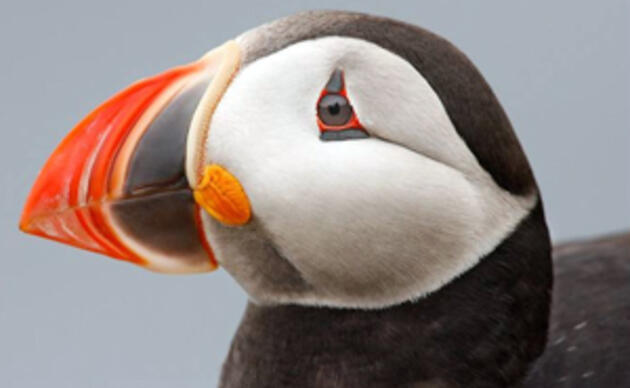For Educators
The Seabird Institute offers hands-on activities that meet Maine learning standards. Taught by “Seabird Sue” Schubel and Susie Meadows, curriculum is available for in the classroom or at the Project Puffin Visitor Center.
In-The-Classroom topics include:
MAINE COAST PUFFIN RESTORATION (and Seabird Conservation Around the World): The groundbreaking work of restoring a seabird colony began in 1973 on a tiny island in Muscongus Bay. Today the restoration techniques are used successfully around the world for many different species. This inspiring story can be told with a slide show, or in a “show and tell” format with props. You’ll learn about the biology of puffins, threats faced by seabirds, and what people are doing to make a positive difference in the world. (“Seabird Sue” Schubel)
BE A BIRD, SEE A BIRD: In this activity, students will “become” several different seabirds so they can appreciate the diversity and life histories of these amazing local creatures. Each group of 3-5 students will be given boxes of clues that will enable them to create a bird using a costume, build its nest, learn its migration route, discover its place in the food web, make its sound, and identify it using a field guide. A convenient data sheet neatly sorts out students’ findings. (“Seabird Sue” Schubel)
THE MARINE ECOSYSTEM (Food Web): Puffins are just one part of the larger ocean community. We will create a complex food web in which students play the parts of marine plants and animals and see the interconnectedness. Each student will also create a food chain mobile. (“Seabird Sue” Schubel)
CURRENT IMPACTS ON SEABIRDS AND THE OCEAN: Students learn about modern-day threats to oceans and wildlife. A hands-on oil spill cleanup is a great way to get students directly involved in thinking about these threats. As small groups devise ways to clean up the oil in their tubs, discussion is stimulated about the difficulties of dealing with real spills. (“Seabird Sue” Schubel)
SEA LIFE ARTS AND CRAFTS: Fabulous and fun arts and crafts: including seabird quilts and murals, puppets, mobiles, pillows and decoys. Learn some biology as you create your masterpiece!! (“Seabird Sue” Schubel)
PUFFINS TO PENGUINS, A TERN AROUND THE WORLD: The Arctic Tern is a master migrant, flying up to 20,000,from Maine to Antarctica and back each year. Imagine the many different countries, people, and environmental conditions it encounters on this incredible journey! We will map out the world in the classroom and migrate our hand-crafted paper terns from place to place. They will be stamped like passports as we learn a bit about these places the birds pass through. The Arctic Tern is one of the few birds in the world to see both puffins and penguins each year. (“Seabird Sue” Schubel)
Project Puffin Visitor Center programming includes:
SEABIRD ADAPTATIONS: How can those little puffins, smaller than a lobster buoy, spend years out on the open ocean? Seabirds are spectacularly adapted to life at sea! Get your camera ready as we dress up a student to be as well suited to life at sea as a puffin. We will also investigate through experimentation how fat keeps a bird warm, and how different types of beaks excel at catching different types of food. Camouflage experiments and studying the waterproof nature of feathers are also possibilities.(Susie Meadows)
THE DANGEROUS AND INTERESTING LIVES OF SEABIRDS: There are many threats to the life of a seabird, and in Puffling’s Journey, students help puffin chicks negotiate an ocean filled with hazards. After responding to this ever-changing environment, students take ownership of the mock ocean environment and speak out as active stakeholders, devising ways to improve the puffin’s survival. Data is collected throughout, and results are compared to real survival data from Maine seabird islands. (Susie Meadows)
LEARNING TO BE A SCIENTIST: Learn to think like a biologist! If you were living on an island with 5,000 seabirds, what questions could you ask and answer? We will focus on one question, which is asked by our biologists year after year on numerous islands, “What do terns feed their chicks?” Students will learn to identify terns and their prey, and will understand the life history of terns. We will use student-drawn sketches in a mock feeding study and compare class data to actual data from the field. Real specimens of terns and fish will be available for viewing. This can be done in one session, but is best as a two class lesson. (Susie Meadows)
SEABIRD RESTORATION HISTORY: The groundbreaking work of restoring a seabird colony began in 1973 on Eastern Egg Rock, a tiny island in Muscongus Bay. Today the restoration techniques are used around the world for many seabird species. Students will learn about the restoration techniques by watching a 20-minute documentary which tells this inspiring story, exploring a research bird blind and answering questions, followed by scavenger hunt. (Susie Meadows)
Learn about birds and take action
Adopt-A-Puffin
Adopt now and receive a Certificate of Adoption, along with a biography of "your" puffin!
Visitor Center
The Project Puffin Visitor Center (PPVC) is located at 311 Main Street in downtown Rockland, Maine. The center opened its doors officially on July 1, 2006.



